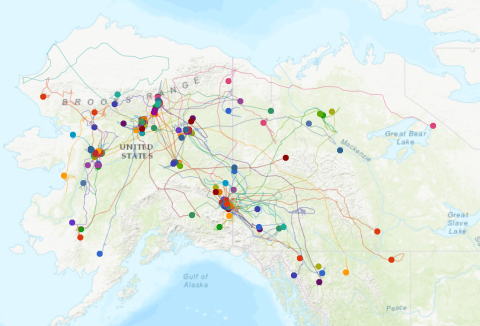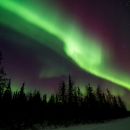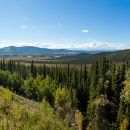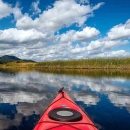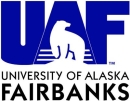The Northwest Boreal Forest Lynx Project is a collaborative effort between the U.S. Fish and Wildlife Service, the University of Alaska Fairbanks, and the National Park Service to study movement patterns, dispersal behavior, and survival of lynx in relation to snowshoe hare abundance.
Canada lynx populations depend on snowshoe hare as their primary prey. Hare populations are cyclical: they go up and down about every 10 years. When hare populations are up, lynx do well. Biologists are studying the movement of lynx across the landscape and asking questions like: What happens when hare populations decline? Do lynx move to areas where the hare population is at a different point in the cycle? How far do lynx disperse and what affects their survival? Biologists annually live-trap lynx in a walk-in traps during late winter during mating season when lynx are active and moving and outfit lynx with radio collars that transmit their location daily. Biologists track the movement of collard individuals using satellite-derived location information that can be downloaded remotely to office computers.
This project uses GPS collars to track the movements of lynx across an enormous area of Interior Alaska, from Tetlin National Wildlife Refuge on the Canadian border, to Yukon Flats Wildlife Refuge and Kanuti Wildlife Refuge north of Fairbanks, north to Gates of the Arctic National Park, and west to Koyukuk National Wildlife Refuge.
For example, since joining the collaborative in 2017, Kanuti Refuge staff captured 20 lynx over two winters and fitted them with GPS collars just north of the refuge near Bettles, Alaska. After a prodigious trek to northwestern Alaska, one settled in Gates of the Arctic National Park, while the other headed east to northeastern Yukon, but still managed to sneak back over the US-Canada border before returning to northeastern Yukon.
Collectively, as of 2022, over 160 lynx have been radio collared. Lynx movements from all study areas are displayed in the figure below. Lynx can move up to 10 miles daily and have been documented to go on treks of over 1,000 miles in a matter months.

